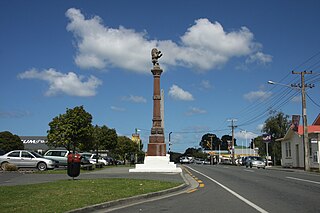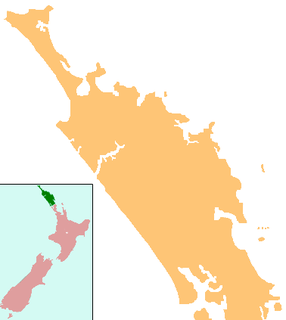The Ahuroa River is a river in the Northland Region of the North Island of New Zealand.
The North River is both a stream and a small settlement on that stream, in Northland Region. The stream flows through limestone caves before entering the Pohuenui River, which in turn flows into the Waipu River before this emerges into Bream Bay near Waipu.

Lake Ohau is a glacial lake in the Mackenzie Basin of New Zealand's South Island. It is fed by the Hopkins and Dobson rivers, which have their headwaters in the Southern Alps, and has its outflow in the Ohau River, which itself feeds into the Waitaki River hydroelectric project.

Opiki is a small rural settlement in the Horowhenua district of New Zealand's North Island. It is located on the floodplain of the Manawatu River, 15 km (9 mi) southwest of Palmerston North.

Mount Hikurangi is a 1,752 m (5,748 ft) peak in the eastern corner of New Zealand's North Island, about 80 kilometres (50 mi) north of Gisborne, and 50 kilometres (31 mi) southwest of the East Cape Lighthouse. On a spur of the Raukumara Range in the Waiapu Valley, it is the North Island's highest non-volcanic peak.

Waipu is a small town in Bream Bay, in the Northland Region of New Zealand, with a Scottish heritage. The population of the town and its surrounds, including Waipu Cove and Langs Beach, was 1,671 in the 2013 Census, an increase of 177 from 2006. A highlight of the town's calendar is the annual Highland Games held at New Year. Near the town are the Waipu Caves, which contain a significant population of glow worms.

Ruakaka is a small town in the north of New Zealand approximately 30 kilometres south of Whangarei in the Bream Bay area. Originally a small beachside community, Ruakaka has seen development due to its proximity to the expansion of the country's only oil refinery at Marsden Point during the 1980s. A recently established timber processing plant at Marsden Point has further stimulated growth.

Matakohe is a settlement in Northland, New Zealand. The Matakohe River is a short river which runs from the north into the Arapaoa River, which is part of the Kaipara Harbour. State Highway 12 passes through Matakohe. Ruawai is 16 km to the west, and Paparoa is 6 km north east. The Hukatere Peninsula extends south into the Kaipara Harbour.
There are also two rivers with the same name in Waikato. One enters Kawhia Harbour,the other the Waikato River.
The Mangakahia River is a river of the Northland Region of New Zealand's North Island. It flows east from its sources in the Mataraua Forest, turning southeastward after about 20 kilometres (12 mi) on joining with the small Awarua River. It is joined by the Opouteke River near Pakotai, then turns east, until it is joined by the Hikurangi River. It then turns south again, passing Titoki and then joining with the Wairua River to form the Wairoa River approximately halfway between Whangarei and Dargaville.
The Mangamaire River is a river of the centre of New Zealand's North Island. One of the headwaters of the Rangitikei River system, it flows generally southwest from its origins southeast of Lake Taupo, forming part of the border of the Kaimanawa Forest Park for much of its length. It meets the young Rangitikei in hill country 40 kilometres (25 mi) east of Mount Ruapehu.
The Manganui o te Ao River is a river of the centre of New Zealand's North Island. It has its source in numerous streams and small rivers which flow west from the slopes of Mount Ruapehu, though the main course of the river flows predominantly southwest through rugged hill country to meet with the Whanganui River 10 kilometres (6 mi) north of Pipiriki, at the edge of the Whanganui National Park.

The Mangatawhiri River is a river of the Auckland and Waikato Regions of New Zealand's North Island. It flows generally southwest from its sources in the Hunua Ranges southeast of Clevedon before flowing through a system of irrigation canals at the northern edge of the Waikato Plains close to the town of Pokeno. It reaches the Waikato River close to the township of Mercer.
The Motupipi River is a short river of the Tasman Region of the South Island of New Zealand. It flows north to reach Golden Bay to the east of Takaka.
The Oruawharo River is a river on the North Auckland Peninsula of New Zealand. It flows westward into the Kaipara Harbour west of Wellsford. It forms part of the boundary between the Northland region and the Auckland Region.
The Oruru River is a river of the Northland Region of New Zealand's North Island. It flows north from its sources south of Mangonui to reach the Taipa River 5 kilometres (3 mi) from Taipa.
The Waihoihoi River is a river of the Northland Region of New Zealand's North Island. it is a tributary of the Waipu River, which it reaches close to the town of Waipu.

Bream Bay is a locality and bay on the east coast of New Zealand. Captain James Cook named this area to include the bay itself, but also some surrounding locations, stretching north to Whangarei and south to Mangawhai. However, 'Bream Bay' is loosely used as a collaboration of the three major towns that satellite the main metropolitan area which are Ruakaka, One Tree Point and Waipu. The physical bay itself geographically spreads from the mouth of Whangarei Harbour, 22 kilometers south, to the southernmost point of Waipu Cove. The area also inhabits 3 native reserve islands, located just off the coast of Bream Bay: the Hen and Chickens Islands and Sail Rock Island.
Alien Weaponry is a heavy metal band from Waipu, New Zealand, formed in 2010 by brothers Henry and Lewis de Jong. The band consists of Henry de Jong (drums), Lewis de Jong, and Ethan Trembath (bass). All three members have Māori ancestry and several of their songs are written in the Māori language.








